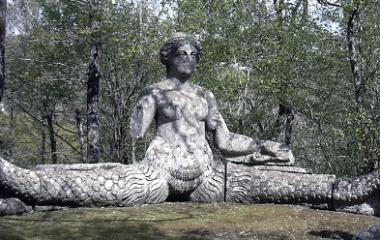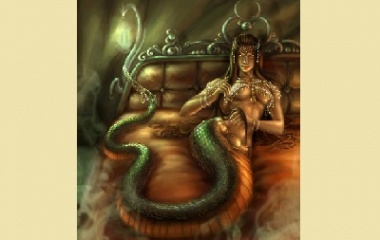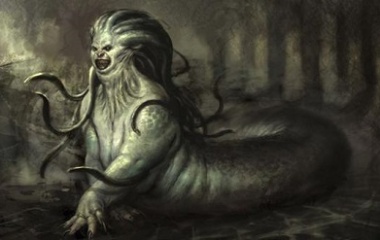- Pronunciation: Ek-id-nuh
- Origin: Greek
- Home: Phrygia, Tartarus
- Role: Guardian of Earth’s Treasures, Mother of All Monsters
- Parents: Gaia and Tartarus, or Keto and Phorkys
- Spouse: Typhon
- Children: Several, including Cerberus, Chimera, Colchian Dragon, Gorgon, Hydra and Sphinx
What Is Echidna?
Echidna is a guardian, goddess, monster, or mother of the sprits that are the alternative to the Olympians, dependent on the source. Regardless of how one views her, as the mother of many of the creatures that Heracles was tasked with killing, her importance to the Greeks is without question.
Origin
Echidna was the daughter of either Gaia and Tartarus, or Keto and Phorkys. Either way, the cave birth of this half-woman, half-serpent would herald a new age in the Greek pantheon, an age in which the birth of her children would present to her the title of “Mother of All Monsters.”
Family
Echidna was married to Typhon who, if her parents were Gaia and Tartarus, was her full brother. Perhaps this would explain the countenance of all of their children together. If her parents were Keto and Phorkys, then perhaps her countenance can be explained as a combination of the features of her beautiful mother, and the monstrous features of her father. Like Echidna, Phorkys’ upper body was humanoid, while his lower half was not. But instead of being a snake, his lower half was that of a fish. His upper half was not handsome, however, but rather covered in crablike skin.
Regardless of her parentage, as the Mother of All Monsters, Echidna’s children with Typhon would figure prominently in the tales of nearly every great hero of Greek mythology.
History
Most of Echidna’s history centers not around her, but rather on her famous children. Her title of Mother of All Monsters is well deserved. Her husband, like Echidna herself, was also half-humanoid and half-snake. Their children, however, were dominated by their monstrous sides.
Many Heroes, Many Deaths
One can presume that Echidna has no love lost for any of the great heroes of Greek mythology. Most of her children were overcome or killed by them. Bellerophon killed Chimera, the three-headed monster that appears to be made of leftover bits from a dragon, a goat, and a lion. Echidna’s child the Colchian Dragon was shown more mercy, and merely lulled to slumber in Jason’s effort to retrieve the Golden Fleece that it guarded. Her half-human, half-lion daughter the Sphinx killed herself, either by throwing herself from a cliff or devouring her own body, when Oedipus was able to answer her riddles. There is very little information on her daughter Gorgon, other than at some point she became three daughters and not one. Euryale, Medusa, and Stheno all shared hideous faces and hair consisting of writhing, angry, serpents. Of the three, only Medusa was mortal, which is probably why the fact of her being a child of Echidna is sometimes questioned. It is probably also why only her death is noted, at the hands of Perseus.
One Hero, Many Deaths
Surely the hero Echidna hated most would be Heracles. In his 12 labors, he bested or killed six of her children. The victim in his first labor was the Nemean Lion, who would become the constellation Leo. His second labor brought him face to face with the Lernaean Hydra, and again, another child of Echidna was slain. In his fourth labor, on a side portion of his quest, Hercules killed the Caucasian Eagle, who may or may not have been a child of Echidna. Hercules would close out the final three labors harassing more of Echidna’s children. On his tenth, he killed the two-headed dog Orthrus while stealing the giant Geryon’s cattle. His eleventh labor saw the death of Echidna’s serpent/dragon child Ladon, when he stole the golden apples in the Garden of Hesperides. Finally, on his twelfth labor, Hercules showed some mercy, and only captured Echidna’s offspring Cerberus – or perhaps the extra head was just too much for the hero.
Other Children
There are a couple of additional monsters from Greek mythology that are sometimes attributed to Echidna. The first is Phaea, also known as the Crommyonian Sow. Theseus gets in on the action in this one, killing her and many other miscreants on his first trip to Athens.
Finally there is Scylla, whom Odysseus had encounted, but was slain by Heracles outside of his labors. She is occasionally attributed to Echidna, but is more often linked to a coupling of Hecate and Typhon.
Current Influence
Echidna is said to live in Tartarus, choosing to be near her husband after his humiliating defeat by Zeus. There are no further records of them having any more children after this event; perhaps the fact that Zeus trapped Typhon underneath Mount Etna had some effect on his libido.
Echidna’s worship place originates in Phrygia, where she was considered to be a guardian of Earth’s treasures. Earthquakes are said to be the result of her moving about, coiling and uncoiling her snake-like lower body. As such, she is often invoked to prevent or minimize damage and injury during these catastrophes.











Thank u this guy at school is babying that I can’t use this and I showed him ha
ur welcome